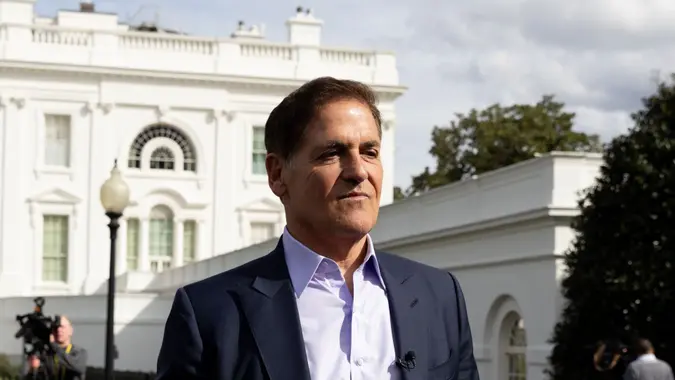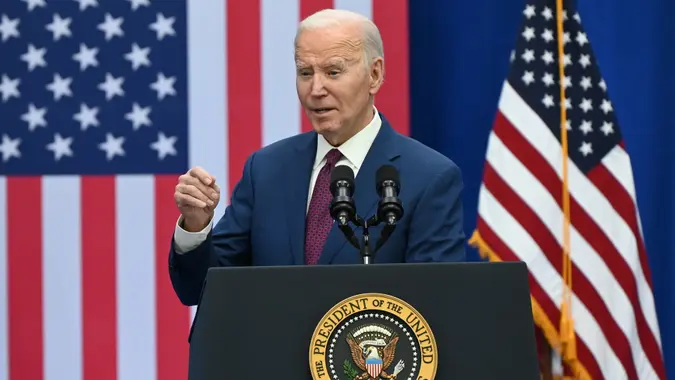I Was 5 Figures in Debt: These 4 Tips From Dave Ramsey Helped Me Get Control of My Finances

Commitment to Our Readers
GOBankingRates' editorial team is committed to bringing you unbiased reviews and information. We use data-driven methodologies to evaluate financial products and services - our reviews and ratings are not influenced by advertisers. You can read more about our editorial guidelines and our products and services review methodology.

20 Years
Helping You Live Richer

Reviewed
by Experts

Trusted by
Millions of Readers
The average American consumer has around $100,000 in debt, according to Experian. While debt loads vary widely and many people owe more or less than that, carrying significant debt can impact nearly every facet of life — from familial relationships to retirement planning.
Check Out: $10K or More in Debt? See If You Could Become Debt-Free (for Less Than You Owe)
The good news is that for every problem, there is a solution. Even if you have a lot of debt, you can still pay it off. It might take some time and planning, but it can be done.
If you’re still in doubt, here are two individuals — Liam Matthews and Jim Christy — who successfully paid off tens of thousands of dollars in debt in just a few years using financial strategies from Dave Ramsey.
Paying Off $45,000 in Just 3 Years: 4 Tips From Ramsey
Liam Matthews, a finance expert and the founder of PropTradingScam.com, shared his story of owing $45,000 and how he got in control of his finances.
“Initially, I had around $45,000 in student loans and credit card debt combined,” he said. “By following Dave Ramsey’s plan, I managed to pay it off in just three years. It wasn’t always easy, and there were sacrifices along the way, but the sense of freedom and accomplishment I felt upon becoming debt-free was truly priceless.”
How Did He Do It?
Matthews followed Ramsey’s “7 Baby Steps,” specifically the ones that tackle debt.
“The financial guru whose advice I primarily followed was Dave Ramsey,” Matthews said. “I resonated with his no-nonsense, straightforward approach to tackling debt.”
In the 7 Baby Steps, there are three specific steps that Matthews focused on:
- Step one is to build a starter emergency fund that has $1,000 in it.
- Step two is to use the debt snowball method to pay off all debt, excluding your mortgage.
- Step three is to save between three and six months’ worth of expenses in the emergency fund you started.
This Baby Steps plan, Matthews said, seemed both manageable and motivating, which is a big reason why he chose to follow it.
“One of the most impactful strategies I implemented from Dave Ramsey’s advice was the debt snowball,” he said. “I listed all my debts from smallest to largest balance, regardless of interest rate. Then, I focused on paying off the smallest debt first while making minimum payments on the others. Once the smallest was paid off, I moved on to the next smallest, adding the previous debt’s payment amount to accelerate the process.”
By doing this — and this is something that rings true for many others who follow the debt snowball method — Matthews was able to use the small wins to stay motivated until he’d become debt-free.
Along with following the debt snowball method, having an emergency fund — whether it’s a starter fund or a fully maxed out one — is key to building financial stability. After all, having that money set aside for the unexpected can keep you from having to take on more debt later on.
“I believe the key principles of Dave Ramsey’s approach are sound,” said Matthews. “Prioritizing debt repayment, budgeting diligently and avoiding additional debt are fundamental steps towards achieving financial freedom.”
One other tip from Ramsey that Matthews said he followed while paying off the $45,000 was cutting back on unnecessary expenses.
“I made a conscious effort to live below my means, cooking at home more, reducing entertainment costs and avoiding impulse purchases,” he said. This let him free up some room in his budget to put toward his debts.
Paying Off $40,000 in 2 Years: 2 Tips from Dave Ramsey
Matthews isn’t the only person who’s successfully followed Ramsey’s advice to pay off a large sum. Jim Christy, the owner and managing director of Midwest Cards, did the same.
“I had around $40,000 in debt, including credit cards and a car loan,” he said. “By following Ramsey’s strategies, I was able to pay off this debt in about two years.”
Which Strategies Did He Use?
The top one was, again, the debt snowball method.
But the other key method was to have a clear budget and stick to it. Doing this made it easier for Christy to control his spending, avoid taking on new debt and focus on paying off his existing debt more quickly.
Choosing the Debt Repayment Method That Works for You
Other finance experts, like Suze Orman, also frequently emphasize the importance of building an emergency fund and paying off debt as quickly as possible to build financial security. There are also many other ways to pay off debt, including:
- Debt avalanche method: This involves paying off the highest-interest debt first while making the minimum payments on other debts. Once you’ve paid off the first debt, you can tackle the next highest interest rate and so on.
- Balance transfer card: If you have good credit and a lot of credit card debt, a 0% APR balance transfer card could be a temporary solution. As long as you pay off the new card’s balance within a certain time frame, you can save money on interest charges.
- Budgeting or debt payoff app: There are several legitimate budgeting apps to help you track your spending and make it easier to create and stick to a budget. These can also help you find ways to free up cash for your debts.
It might take some experimenting to find the strategy — or strategies — that best work for you, so don’t feel like you need to stick to one expert’s advice. Depending on your situation, preferences and goals, you might find that it’s better to combine several strategies or even come up with one that’s uniquely your own.
More From GOBankingRates
 Written by
Written by  Edited by
Edited by 



























